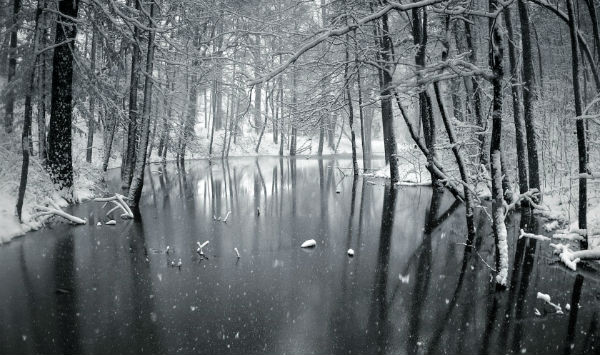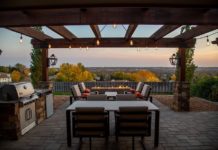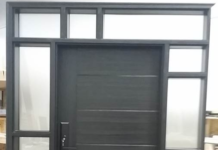It’s the most wonderful time of the year. But that doesn’t mean it doesn’t come with it’s fair share of headaches, especially if you don’t prepare your home and garden properly. Frozen pipes, fallen tree limbs, ice dams. The list of winter-related disasters that can occur without proper preparation is endless. Needless to say, there are a number of tasks that you need to tackle to ensure your home is ready for the upcoming season. To help keep you on track, we’ve created a pre-winter maintenance checklist below.

#1: Protect the flooring of your entryway.
People will be coming in your front door all throughout the season, bringing in an assortment of ice, snow, road salt, mud, and sand with them. These can all cause havoc on the floors in your entryway. To prolong the lifespan and aesthetics of your floors, put place mats outside and inside the door. In addition, don’t forget to have a waterproof tray where wet and dirty shoes can be stored. Also, you’ll need to have a boot scraper or brush to ensure you get most of the muck out before storing your shoes away. If you have a mudroom, make sure that you have a place where you can hang wet jackets, gloves, and other outerwear. You don’t want to drip all over the floors that you made such an effort to protect.
#2: Check your heating system.
If you want to make sure that you’re comfortable all winter long, you need to make sure that your heating system is running smoothly. Regularly change the air filters. If you have a high-efficiency heating system, check the PVC vent pipes to make sure that they’re cleared of any debris or other types of obstructions. You also need to make sure that your boiler and furnace gets cleaned regularly.
#3: Check the batteries in the smoke and carbon monoxide detectors.
Almost 30% of structure fires in the country happen during the winter months according to the US Fire Administration. In addition, when you’re running your heater regularly, you need to make sure that there is no build up of carbon monoxide in your home. Having fresh batteries in your smoke detector as well as your carbon monoxide detector will help ensure that you and your family remain safe all winter long.
#4: Inspect your fireplace and chimney.
Speaking of fire and carbon monoxide poisoning, you’ll need to make sure that your fireplace and chimney are free from buildup of creosote. Have a certified chimney sweep also check if there are leaves, nests, and other debris that might be blocking your chimney. Moreover, check to make sure that your chimney has no cracks and that the flue is functioning properly to prevent drafts.
#5: Weatherproof your doors and windows.
You need to make sure that there are no gaps and areas around your doors and windows that might cause air leaks. To boost the energy efficiency of your home and keep it comfortably warm in all areas, you’ll need to seal up your leaky doors and windows. This includes repairing cracks in caulking or weatherstripping. To further prevent any cold drafts, make sure to also check outside faucets, air vents, and your foundation walls for cracks and gaps.
#6: Remove your window screens.
In addition to weatherproofing your windows, you also need to take out your window screens if you have any. Doing this will help increase the amount of natural light getting into your home which boosts the amount of solar heat gain. Moreover, when it snows, it’s possible for some of the snow to get trapped between the screen and your window which could damage the window frame and sill.
#7: Prevent frozen pipes.
We all know that water expands when it freezes. But what few realize is that when this happens in your pipes, it can cause them to burst. No one wants to deal with the kind of damage water can do to a home as well as your belongings. Not to mention, the amount of money it’ll cost you to repair everything. So, keeping your pipes from freezing is paramount to prepping your home for winter. There are several steps to do this. First, you need to insulate your pipes, particularly ones that are near windows and doors as well as those located in areas of your home that are unheated. Second, make sure that your heat stays on even if you’re away from home. Doing so will keep your pipes warm, preventing water from freezing. The recommended temperature is at least 55 degrees Fahrenheit. And third, make sure that you leave your faucets dripping a little. When water keeps flowing, it’s harder for water to freeze. One last thing you should do is to disconnect your garden hose from the outside faucet.
#8: Protect your sump pump.
For those of you who don’t know, your sump pump is what keeps your basement dry when storms might cause it to become flooded. During winter, it’s possible for water in the pipes and the discharge hose of your sump pump to freeze. To prevent this, remove the hose and leave it until the weather gets warmer. Clear the pit of any debris to avoid clogging. In addition, regularly test your sump pump to make sure that it’s still working properly even during the winter months. Check if the water is being discharged away from the foundation of your home.
#9: Prevent ice dams from forming.
Different roof surface temperatures can cause the creation of ice dams. The edge of your roof is typically colder than the upper portion due to insulation below it (in your attic). This causes the snow on the upper portion of your roof to melt while those near the edge become ice. When the melted ice flows down, it hits that cold edge and becomes frozen, causing the amount of ice to grow. This can continue to happen until bam – you have an ice dam. When this happens, your roof can get leaks and get permanently damaged.
One way to prevent ice dams from forming is to remove snow from your roof as quickly as possible. Make sure that you get a roof rake. But that’s not enough. You should also consider keeping your roof cold. Proper insulation and ventilation can prevent different roof surface temps, preventing the formation of ice dams. Installing heat cables can also ensure that any ice forming on the edge of your roof will melt and flow out.
#10: Clear your gutters.
Your gutter can easily get clogged with melted snow if it’s full of debris such as sticks and leaves. A clogged gutter can cause water to back up which can result in leaks and the formation of an ice dam. The frozen leaves and ice will strain your gutters and cause thawing damage later on. So, make sure to get on a ladder and scoop out all the debris and dirt before flushing the gutters with water. Also, make sure to check the direction of the flow of downspout water. It should flow away from your home’s foundation to prevent flooding in your basement.
#11: Keep an eye on your trees.
Snow can settle on the limbs of your trees. This can make them heavy enough to break which is dangerous, even more so if the limb is near your house. You need to make sure to brush snow off the limbs of your tree after a big snowfall.
Before winter sets in, you should make sure to have any dead tree limbs pruned. These can easily break during a winter storm. It’s best to consult a tree care service company to do the pruning because this is dangerous work. A professional will also be capable of determining whether a tree will need to be trimmed or removed altogether in preparation for winter. Pro Tip: Look for an arborist that uses a type of tree care business software. This way, you can get your home scheduled for a regular visit each year – right before winter comes.













![Best Crochet Hooks for Beginners and Pros [2020 Update] best crochet books](https://www.awebtoknow.com/wp-content/uploads/2018/01/best-crochet-books-100x70.jpg)


